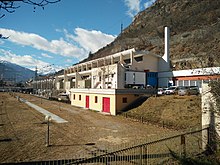Alperia
| Alperia AG
|
|
|---|---|
| legal form | Corporation |
| founding | 2016 |
| Seat |
Bolzano , Italy |
| management |
|
| Number of employees | 991 (2018) |
| sales | 1.272 billion . EUR (2017) (2018) |
| Branch | power supply |
| Website | www.alperiagroup.eu |
The Alperia AG is an Italian power company , which in South Tyrol energy from hydroelectric power produced.
Companies
The company was founded in January 2016 through the merger of Etschwerke (AEW) and SEL AG. The owners are the Autonomous Province of Bolzano South Tyrol, the municipalities of Bolzano and Merano and the SELFIN company. The merger has been the subject of controversial public debate.
Alperia operates 41 hydropower plants , which use the water from the surrounding mountains to generate around 4,000 GWh of electricity annually, as well as six mostly wood-fired biomass heating plants and supplies 278,000 customers with electricity and gas. In the towns of Bozen , Meran , Klausen , Latzfons , Sexten and Schlanders , households are supplied with district heating. The company is also involved in two photovoltaic systems in Italy and in the expansion of the infrastructure for electric vehicles with currently more than 50 charging stations in South Tyrol.
On June 1, 2016, Alperia took over the stakes in nine large South Tyrolean power plants from the Italian Edison group. Alperia is now 100% owner of the seven former Hydros hydropower plants and holds 77% of the two SELEDISON power plants. In the course of the called South Tyrolean state parliament the state government to mandate Alperia to return the investments in smaller hydropower plants to the respective communities.
Power plants
Töll and Meran hydropower plant
The hydropower plant on the Töll was put into operation in 1898. With this large hydropower plant, the use of hydropower to generate energy began there. The original purpose was the supply of electricity for the first street lighting in the cities of Bolzano and Merano. The Marling hydropower plant was built around 20 years later .
The hydropower of the Etsch can be used between the Töll and Marling rivers due to its relatively high gradient of 200 meters without additional pumping.
Töll hydropower plant
The Töll hydropower plant forms the first stage of the power plant complex in the Töll-Meran section. The water that is used to generate energy comes from a catchment area of 1,650 square kilometers. This catchment area includes the entire Vinschgau and some larger glacier areas in South Tyrol. On the Töll, the water is collected by 16 meter long weirs and then flows into the turbine sets .
Marling hydropower plant
The water, which was already used in the Töll hydropower plant, now flows via a gravity pipe into the Marling hydropower plant below. This hydroelectric power station was built around 1918 and renovated between 2002 and 2004. Since then it has produced 250 million k Wh of electricity per year.
Naturno hydropower plant
The Naturno hydropower plant uses hydropower from the Vernagt reservoir to generate electricity . It is therefore the largest high pressure hydropower plant in South Tyrol.
Hydroelectric power station Kardaun
The Kardaun hydroelectric power station uses the water power of the Eisack to generate electricity . It has a catchment area of around 4,193 square kilometers and produces 600 million kWh of electricity per year. It is therefore the largest hydropower plant in South Tyrol.
Barbian hydroelectric power station
The Barbian hydropower station also uses the Eisack's hydropower to generate electricity. It produces 240 million kWh of electricity per year and has the highest water flow of all hydropower plants in South Tyrol.
Glurns and Kastelbell hydroelectric power station
The hydropower plant Glurns forms the first stage of the Reschensee - underground power plant . The water is transferred from the Reschensee, which was built between 1947 and 1949. The water that has already been used is partly diluted and partly fed to an equalization basin via channels that flow on the surface . From there the water returns to the Adige via the Puni . The water supply to the Kastelbell power plant can be regulated through the equalization basin .
Brixen hydroelectric power station
The Brixen hydropower plant draws its water from the Franzensfester reservoir and the Mühlbach reservoir , which are fed by the Eisack, Rienz and other smaller streams.
Ultental hydropower plants
In Ultental , Alperia Greenpower, a subsidiary of Alperia, operates the Weißbrunn, St. Walburg, Kuppelwies, St. Pankraz and Lana hydropower plants via a total of six reservoirs.
Web links
- Alperia Group website (Italian, German, English)
- Alperia AG website (Italian, German)
Individual evidence
- ↑ Kathrin Madl: Bilancio di sostenibilità della Alperia. (PDF) In: AlperiaGroup.eu. P. 7 , accessed on July 19, 2019 (Italian).
- ↑ Kathrin Madl: Bilancio di sostenibilità della Alperia. (PDF) In: AlperiaGroup.eu. P. 69 , accessed on July 19, 2019 (Italian).
- ↑ Press report Südtirolnews from December 4, 2015 ( Memento from June 1, 2016 in the Internet Archive )
- ↑ Alperia: Are the population and employees left with nothing? Our Tyrol, May 29, 2016, accessed on June 4, 2016 .
- ↑ Resolution Request: Withdrawal of ALPERIA AG of investments in small hydropower plants. Free Alliance for Tyrol, March 3, 2016, accessed on June 4, 2016 .




